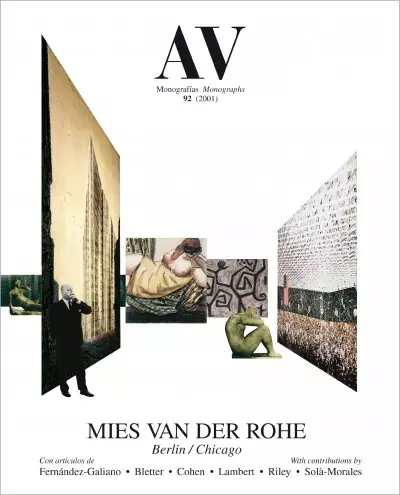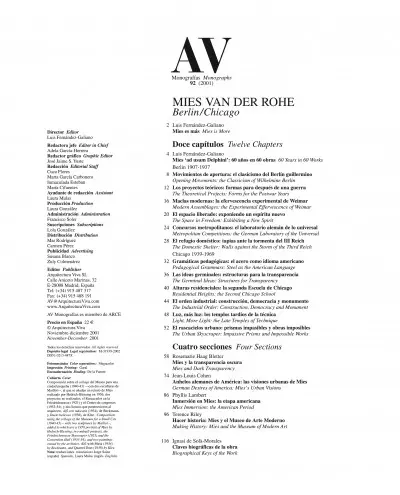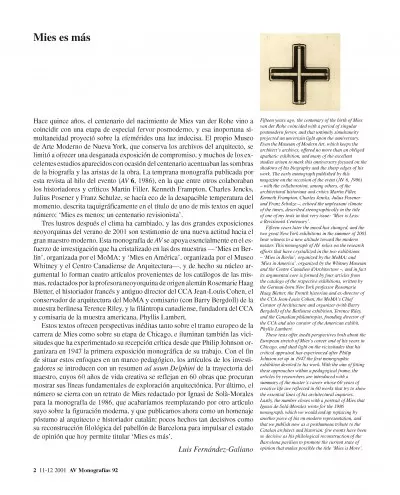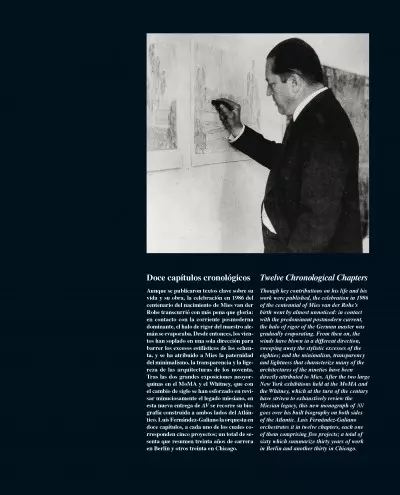MIES VAN DER ROHE
Berlin / ChicagoLuis Fernández-Galiano
Mies es más
Mies is More
Doce capítulos
Twelve Chapters
Luis Fernández-Galiano
Mies ‘ad usum Delphini’: 60 años en 60 obras60 Years in 60 Works
Berlin 1907-1937
Movimientos de apertura: el clasicismo del Berlín guillermino
Opening Movements: the Classicism of Wilhelmine Berlin
Los proyectos teóricos: formas para después de una guerra
The Theoretical Projects: Forms for the Postwar Years
Maclas modernas: la efervescencia experimental de Weimar
Modern Assemblages: the Experimental Effervescence of Weimar
El espacio liberado: exponiendo un espíritu nuevo
The Space in Freedom: Exhibiting a New Spirit
Concursos metropolitanos: el laboratorio alemán de lo universal
Metropolitan Competitions: the German Laboratory of the Universal
El refugio doméstico: tapias ante la tormenta del III Reich
The Domestic Shelter: Walls against the Storm of the Third Reich
Chicago 1939-1969
Gramáticas pedagógicas: el acero como idioma americano
Pedagogical Grammars: Steel as the American Language
Las ideas germinales: estructuras para la transparencia
The Germinal Ideas: Structures for Transparency
Alturas residenciales: la segunda Escuela de Chicago
Residential Heights: the Second Chicago School
El orden industrial: construcción, democracia y monumento
The Industrial Order: Construction, Democracy and Monument
Luz, más luz: los templos tardíos de la técnica
Light, More Light: the Late Temples of Technique
El rascacielos urbano: prismas impasibles y obras imposibles
The Urban Skyscraper: Impassive Prisms and Impossible Works
Cuatro secciones
Four Sections
Rosemarie Haag Bletter
Mies y la transparencia oscura
Mies and Dark Transparency
Jean-Louis Cohen
Anhelos alemanes de América: las visiones urbanas de Mies
German Desires of America: Mies’s Urban Visions
Phyllis Lambert
Inmersión en Mies: la etapa americana
Mies Immersion: the American Period
Terence Riley
Hacer historia: Mies y el Museo de Arte Moderno
Making History: Mies and the Museum of Modern Art
Ignasi de Solà-Morales
Claves biográficas de la obra
Biographical Keys of the Work
Luis Fernández-Galiano
Mies is More
Fifteen years ago, the centenary of the birth of Mies van der Rohe coincided with a period of singular postmodern fervor, and that untimely simultaneity projected an uncertain light upon the anniversary. Even the Museum of Modern Art, which keeps the architect’s archives, offered no more than an obliged apathetic exhibition, and many of the excellent studies arisen to mark this anniversary focused on the shadows of his biography and the sharp edges of his work. The early monograph published by this magazine on the occasion of the event (AV6, 1986) – with the collaboration, among others, of the architectural historians and critics Martin Filler, Kenneth Frampton, Charles Jencks, Julius Posener and Franz Schulze –, echoed the unpleasant climate of the times, described stenographically in the title of one of my texts in that very issue: ‘Mies is Less: a Revisionist Centenary’.
Fifteen years later the mood has changed, and the two great New York exhibitions in the summer of 2001 bear witness to a new attitude toward the modern master. This monograph of AV relies on the research efforts that have crystallized in the two exhibitions – ‘Mies in Berlin’, organized by the MoMA; and ‘Mies in America’, organized by the Whitney Museum and the Centre Canadien d'Architecture –, and in fact its argumental core is formed by four articles from the catalogs of the respective exhibitions, written by the German-born New York professor Rosemarie Haag Bletter, the French historian and ex-director of the CCA Jean-Louis Cohen, the MoMA’s Chief Curator of Architecture and organizer (with Barry Bergdoll) of the Berlinese exhibition, Terence Riley, and the Canadian philantropist, founding director of the CCA and also curator of the American exhibit, Phyllis Lambert.
These texts offer inedit perspectives both about the European stretch of Mies’s career and of his years in Chicago, and shed light on the vicissitudes that his critical appraisal has experienced after Philip Johnson set up in 1947 the first monographic exhibition devoted to his work. With the aim of fitting these approaches within a pedagogical frame, the articles by researchers are introduced with a summary of the master’s career whose 60 years of creative life are reflected in 60 works that try to show the essential lines of his architectural inquiries. Lastly, the number closes with a portrait of Mies that Ignasi de Solá-Morales wrote for the 1986 monograph, which we would end up replacing by another piece of his on modern representation, and that we publish now as a posthumous tribute to the Catalan architect and historian: few events have been so decisive as his philological reconstruction of the Barcelona pavilion to promote the current state of opinion that makes possible the title ‘Mies is More’.








